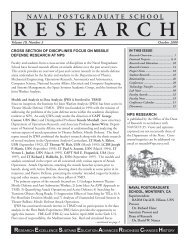Spectral Unmixing Applied to Desert Soils for the - Naval ...
Spectral Unmixing Applied to Desert Soils for the - Naval ...
Spectral Unmixing Applied to Desert Soils for the - Naval ...
You also want an ePaper? Increase the reach of your titles
YUMPU automatically turns print PDFs into web optimized ePapers that Google loves.
III. DESERT ECOSYSTEM CHARACTERISTICS<br />
A. DESERTS AND THEIR DISTRIBUTION<br />
1. Humans and <strong>the</strong> Arid Environment<br />
By definition, deserts are arid or semi-arid regions where rainfall is <strong>the</strong> limiting<br />
fac<strong>to</strong>r <strong>for</strong> productivity and/or is unpredictable <strong>to</strong> <strong>the</strong> point that growing crops is not<br />
possible (Whit<strong>for</strong>d, 2002). Biological constituents of a desert are often considered <strong>to</strong> be<br />
living at or near <strong>the</strong>ir threshold of <strong>to</strong>lerance <strong>for</strong> a given environmental or ecological<br />
condition; resulting in local extinctions of some species when <strong>the</strong>y are stressed beyond<br />
<strong>the</strong>ir ability <strong>to</strong> cope (Whit<strong>for</strong>d, 2002). <strong>Desert</strong> ecosystems have been found <strong>to</strong> be so<br />
sensitive that constant disturbances have been known <strong>to</strong> cause change in both <strong>the</strong><br />
structure and function within <strong>the</strong> region itself and extending <strong>to</strong> surrounding ecosystems<br />
(Webb et al., 2009). One example of how anthropogenic disturbances alter desert<br />
ecosystems is <strong>the</strong> distribution of plant communities and <strong>the</strong> close correlation of human<br />
impacts with increased rates of non-native plant invasions (Webb et al., 2009). O<strong>the</strong>r<br />
changes are decreases in soil conductivity (electricity) because of impact-related<br />
decreases in soil porosity. These alterations lead <strong>to</strong> higher erosion rates and wind<br />
transporting of soil materials (Prose, 1985). Because structural characteristics of soils<br />
affect all processes in <strong>the</strong> desert environment, links can be established between bio-<br />
chemical interactions and human-related impacts (Prose, 1985; Whit<strong>for</strong>d, 2002) based on<br />
changes in reflectance within hyperspectral imagery (Smith et al., 2004).<br />
2. <strong>Desert</strong> Biomes<br />
According <strong>to</strong> Whit<strong>for</strong>d (2002), desert biomes cover roughly one-third of <strong>the</strong><br />
Earth’s surface, occurring in areas with less than 50 cm/year of rainfall. Figures 8 and 9<br />
illustrate a distribution of desert regions and correlating soil types, respectively.<br />
.<br />
17
















